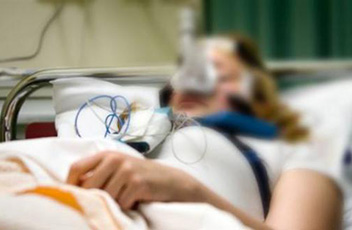 Absolutely everyone knows the term "coma", realizing that this is a dangerous condition that occurs with severe brain damage. There are different kinds or stages of coma. One of them: persistent vegetative state.
Absolutely everyone knows the term "coma", realizing that this is a dangerous condition that occurs with severe brain damage. There are different kinds or stages of coma. One of them: persistent vegetative state.
What is a vegetative state and how does it look like?
Sometimes this syndrome is called a wakeful coma. In this condition, the autonomic functions of the nervous system are preserved. In other words, the patient breathes, swallows, defecates him(her)self reflectively. But consciousness is absent. The patient does not respond to speech, does not fix the sight. Sometimes the reaction to pain persists.
A person falls asleep and wakes up, regardless of the change of day and night. When he (she) wakes up, opens eyes, but, as we have already noted, they do not look at objects, do not follow the external movement.
Mimicry is absent - spontaneous movements, yawning, salivation, cries, coughing are possible. The limbs are slightly bent. The fingers and toes are compressed. Chaotic movements are possible.
The main cause of this condition is the damage of the cerebral cortex. Vegetative state can arise as a consequence of:
• Head trauma;
• Poisoning;
• Infectious lesions;
• Severe eating and breathing disorders in the brain;
In some cases, this condition is a stage of exit from a deep coma. In others, the patient develops a vegetative state, as the final stage of a severe disease.
Do not think that a person falls into this state at one time, although this is possible. But this condition can develop gradually. The duration of the state is different. It can be fixed for several days, but, sometimes, patients are in it for several years. The outcome of this state can be any. We must understand that everything depends on the state of the nervous system and the reasons that caused its defeat. If unfavorable factors are eliminated, treatment and restoration of brain functions is possible - the patient can return to consciousness.
There are cases when a person completely restored physical and mental health, after a vegetative state. The abilities and strengths of the organism that compel him (her) to overcome dangerous situations are enormous, especially in children. It is in childhood that the most favorable outcome is most anticipated. However, often a loss of some of the cognitive functions is observed, and dementia remains in the patient who wakes after vegetative coma. A fatal outcome is also possible if the disorders of the nervous system are irreversible.
Determining the prognosis for coma is important because of the need to redistribute material resources and to limit intensive activities in hopeless cases. At present, there are no clear clinical signs (except for those that indicate brain death) that determine the coma forecast. In children and young patients, recovery can be noted even in cases where there are prognostically unfavorable signs, such as a violation of stem reflexes.
Thus, the prognosis for vegetative coma can be determined only approximately, taking into account the age of the patient and the concomitant diseases.
Speaking about the predictions when diagnosing, most often everything depends on how long the pathological change in the patient's body lasts. So, speaking about the recovery from vegetative coma and exit from it, after a 3-month period after the traumatic nature of brain and brain damage and a 12-month period after the injury - the forecasts in this case are disappointing and the way out of it, if it happens, is extremely rare.
According to medical statistics, a patient's improvement can be diagnosed in a later period. For example, in 3 out of 100 cases, improvement can be diagnosed after 5 years - the ability to communicate is restored, but here it is impossible to return to the previous standard of living. More than half of the patients with this diagnosis die during the six-year period due to infection of the lungs, the urinary system, if multi-organ failure is diagnosed, and due to other unidentified factors.
In other cases, the patient in the vegetative state may live for several years or dozens of years - the duration of life depends directly on how well is taken care of the person, whether preventive measures are taken, and very laborious. The patient will have to turn over regularly to avoid bedsores, hygiene procedures, sanitation of the lungs are necessary. If all this is not done - the lethal outcome comes from concomitant complications, most often infectious theology.
Vegetative state treatment:
It is obvious that patients in this condition should receive large-scale medical care and 24-hour care. It is necessary to monitor the function of breathing, to maintain them if necessary. Nutrition of such patients also should be special. The state of the brain can be controlled by means of electroencephalograms and tomography. By results of these researches it is visible:
• Which parts of the nervous system are damaged;
• What is the degree of their defeat;
• Whether the state of the brain changes with time;
It is very important to carry out a complex of measures to support the vital activity of the whole organism and the nervous system. The patient should receive medicines for respiratory tract that optimize breathing and nutrition of the nerve tissue - nootropics, vitamins, adaptogens. Physiotherapeutic procedures should be performed, for example, massages, reflexotherapy.





